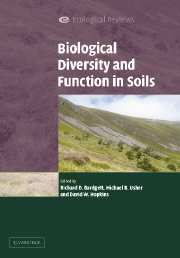Book contents
- Frontmatter
- Contents
- List of contributors
- Preface
- Acknowledgements
- PART I Introduction
- PART II The soil environment
- 2 The habitat of soil microbes
- 3 Twenty years of molecular analysis of bacterial communities in soils and what have we learned about function?
- 4 Carbon as a substrate for soil organisms
- PART III Patterns and drivers of soil biodiversity
- PART IV Consequences of soil biodiversity
- PART V Applications of soil biodiversity
- PART VI Conclusion
- Index
- References
2 - The habitat of soil microbes
Published online by Cambridge University Press: 17 September 2009
- Frontmatter
- Contents
- List of contributors
- Preface
- Acknowledgements
- PART I Introduction
- PART II The soil environment
- 2 The habitat of soil microbes
- 3 Twenty years of molecular analysis of bacterial communities in soils and what have we learned about function?
- 4 Carbon as a substrate for soil organisms
- PART III Patterns and drivers of soil biodiversity
- PART IV Consequences of soil biodiversity
- PART V Applications of soil biodiversity
- PART VI Conclusion
- Index
- References
Summary
SUMMARY
This chapter deals with the impact of the soil's physical habitat on the operation of soil microbes.
The importance of the spatial and temporal nature of soil structural heterogeneity is emphasised.
The moisture characteristic is revealed as having a pre-eminent impact on soil biology.
The sensory ecology of nematodes is described in relation to the chemotaxis process.
Introduction
All terrestrial life lives and moves in the context of a more or less physically structured environment. The antelopes have their veldt, the mountain goats their crevasses, the rabbits their warrens and soil microbes their dark recesses of soil structure. How each individual, population and community operates is defined to a large extent by the physical landscape in which they live, which serves to partition substrate, mates, predators, water, gases and so forth. Geography, even the microgeography of the soil, sorts and drives the species in earth and on Earth.
Much has been published in relation to the so-called aggregate sizes and the presence of microorganisms. For example, Vargas and Hattori (1986) are convinced that there is order in soil, with bacteria living in the centre of aggregates more often than on the surface. Linn and Doran (1984) link the direct influence of soil structure to changes in microbial activity and community structure at the field scale. Work from The Netherlands has produced conclusive proof that the structure of soil, and the attendant moisture, are controlling factors in predator–prey interactions between bacteria and protozoa (e.g. Kuikman et al. 1989; Postma ' van Veen 1990), an area that Young et al. (1994) and Young and Crawford (2001) revisited with respect to the impact of structure on substrate location and accessibility.
- Type
- Chapter
- Information
- Biological Diversity and Function in Soils , pp. 31 - 43Publisher: Cambridge University PressPrint publication year: 2005
References
- 13
- Cited by



